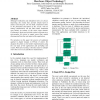Free Online Productivity Tools
i2Speak
i2Symbol
i2OCR
iTex2Img
iWeb2Print
iWeb2Shot
i2Type
iPdf2Split
iPdf2Merge
i2Bopomofo
i2Arabic
i2Style
i2Image
i2PDF
iLatex2Rtf
Sci2ools
117
Voted
FPL
1999
Springer
1999
Springer
IP Validation for FPGAs Using Hardware Object Technology
Although verification and simulation tools are always improving, the results they provide remain hard to analyze and interpret. On one hand, verification sticks to the functional description of the circuit, with no timing consideration. On the other hand, simulation runs mainly on subsets of the entire input domain. Furthermore, these tools provide results in a format (e.g. state graphs, bit vectors or signal waves) that remain disconnected from the real output of the application. We introduce in this paper the process of validation applied to digital designs in FPGAs. It allows the designer the ability to test his/her implementation using the real data of the application and providing real results. With such real data, it becomes easier to identify where the error occurs and then to understand it.
Related Content
| Added | 04 Aug 2010 |
| Updated | 04 Aug 2010 |
| Type | Conference |
| Year | 1999 |
| Where | FPL |
| Authors | Steve Casselman, John Schewel, Christophe Beaumont |
Comments (0)

